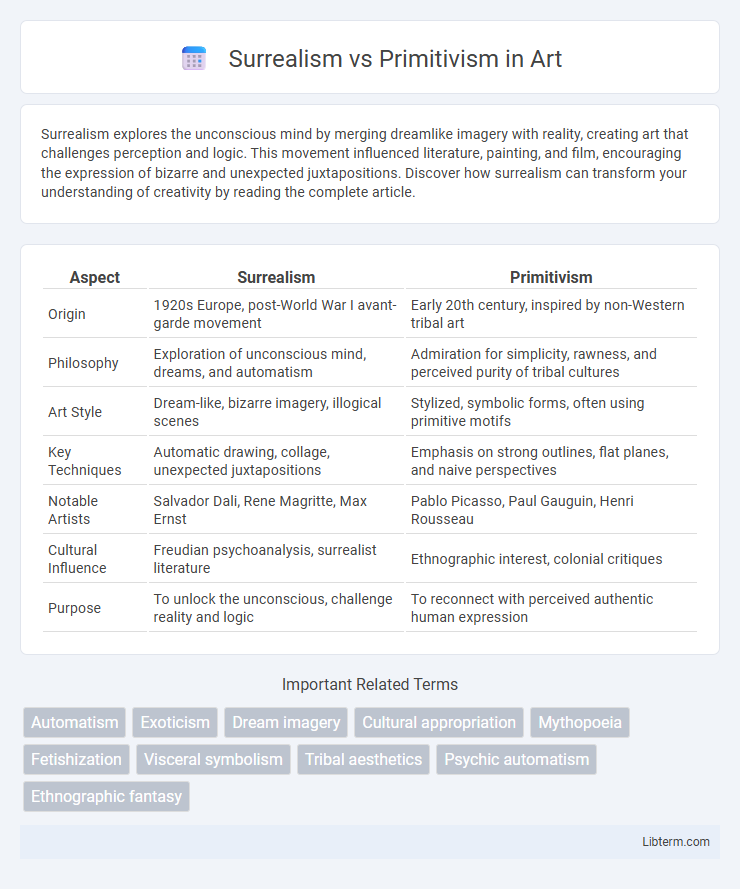Surrealism explores the unconscious mind by merging dreamlike imagery with reality, creating art that challenges perception and logic. This movement influenced literature, painting, and film, encouraging the expression of bizarre and unexpected juxtapositions. Discover how surrealism can transform your understanding of creativity by reading the complete article.
Table of Comparison
| Aspect | Surrealism | Primitivism |
|---|---|---|
| Origin | 1920s Europe, post-World War I avant-garde movement | Early 20th century, inspired by non-Western tribal art |
| Philosophy | Exploration of unconscious mind, dreams, and automatism | Admiration for simplicity, rawness, and perceived purity of tribal cultures |
| Art Style | Dream-like, bizarre imagery, illogical scenes | Stylized, symbolic forms, often using primitive motifs |
| Key Techniques | Automatic drawing, collage, unexpected juxtapositions | Emphasis on strong outlines, flat planes, and naive perspectives |
| Notable Artists | Salvador Dali, Rene Magritte, Max Ernst | Pablo Picasso, Paul Gauguin, Henri Rousseau |
| Cultural Influence | Freudian psychoanalysis, surrealist literature | Ethnographic interest, colonial critiques |
| Purpose | To unlock the unconscious, challenge reality and logic | To reconnect with perceived authentic human expression |
Understanding Surrealism: Origins and Key Concepts
Surrealism, emerging in the early 1920s, originated as a literary and artistic movement driven by the exploration of the unconscious mind, inspired by Freudian psychoanalysis. Key concepts include automatism, dream imagery, and the juxtaposition of irrational elements to challenge rational thought and depict alternative realities. This movement contrasts with Primitivism by focusing on inner psychological landscapes rather than the idealization of non-Western cultures and simpler societal forms.
Defining Primitivism: Artistic Roots and Influences
Primitivism in art draws inspiration from the visual languages of indigenous cultures, often emphasizing simplicity, raw forms, and a return to perceived primal instincts. It emerged in the early 20th century as Western artists sought to break free from traditional academic conventions by integrating motifs from African, Oceanic, and Native American art. This movement profoundly influenced modernist trends, foregrounding an exploration of cultural "otherness" and a critique of industrialization through an aesthetic rooted in perceived authenticity and organic expression.
Historical Context: Early 20th Century Art Movements
Surrealism and Primitivism emerged as pivotal art movements in the early 20th century, reflecting profound cultural shifts and reactions against industrialization and traditional norms. Surrealism, founded in the 1920s by Andre Breton, sought to access the unconscious mind through dream imagery and irrational juxtapositions, influenced by Freudian psychoanalysis. Primitivism drew inspiration from non-Western and indigenous art forms, emphasizing raw, unrefined aesthetics that challenged Western artistic conventions and colonial perspectives during the same period.
Visual Language: Symbolism in Surrealism
Surrealism employs a complex visual language rich in symbolism, using dream-like imagery and unexpected juxtapositions to explore the subconscious mind and challenge rational perception. Symbols in surrealist art often draw from psychoanalysis, mythology, and personal iconography, creating layered meanings that evoke mystery and provoke emotional responses. Unlike Primitivism, which draws on simplified forms and cultural motifs from non-Western societies, Surrealism's symbolism emphasizes inner psychological landscapes and the liberation of imagination.
Embracing the "Primitive": Motifs and Methods
Surrealism and Primitivism both embrace the "primitive" through distinct motifs and methods, employing raw, unconscious imagery to evoke a sense of untamed creativity and cultural authenticity. Surrealists utilize dreamlike, automatist techniques to access the subconscious, drawing from mythic and tribal symbols to disrupt rationality, while Primitivism directly borrows aesthetic elements from indigenous and non-Western art forms, valuing simplicity, bold patterns, and symbolic representation. These approaches highlight the artists' quest to transcend modern industrial constraints by reconnecting with elemental human experiences and ancestral visual languages.
Major Figures: Iconic Surrealist and Primitivist Artists
Salvador Dali, Rene Magritte, and Max Ernst stand out as iconic figures in Surrealism, celebrated for their dreamlike imagery and exploration of the unconscious mind. Primitivism highlights artists like Pablo Picasso, Henri Matisse, and Paul Gauguin, who drew inspiration from African, Oceanic, and indigenous art to challenge Western artistic conventions. Both movements significantly shaped modern art, with surrealists emphasizing psychological depth and primitivists focusing on raw, elemental aesthetics.
Contrasting Techniques: Dreams vs. Raw Expression
Surrealism employs intricate techniques rooted in dream analysis and the unconscious mind, using automatic writing and unexpected juxtapositions to evoke surreal imagery. Primitivism, in contrast, emphasizes raw, instinctive expression through simplified forms and bold, unrefined visuals derived from non-Western and tribal art. These contrasting techniques highlight Surrealism's exploration of inner fantasy worlds versus Primitivism's direct connection to fundamental human emotions and cultural origins.
Cross-Cultural Influence and Appropriation Debates
Surrealism drew heavily from non-Western art forms, incorporating indigenous imagery and motifs to explore the unconscious mind, while Primitivism idealized and romanticized so-called "primitive" cultures as sources of artistic purity. The cross-cultural influence sparked intense debates on appropriation, with critics arguing that these movements often commodified and misrepresented marginalized cultures without proper context or respect. Contemporary scholarship emphasizes the need to recognize power imbalances inherent in this dynamic, advocating for ethical engagement and acknowledgment of indigenous voices in art history.
Legacy and Impact on Contemporary Art
Surrealism revolutionized contemporary art by inspiring explorations into the subconscious and dream imagery, influencing movements like Abstract Expressionism and Neo-Surrealism. Primitivism left a lasting impact through its embrace of non-Western aesthetics and raw forms, challenging traditional norms and paving the way for modernist abstraction and cultural hybridity in art. Both movements reshaped visual language, encouraging artists to break boundaries and integrate diverse cultural elements into their work.
Surrealism vs. Primitivism: Points of Intersection and Divergence
Surrealism and Primitivism intersect in their fascination with the unconscious and the rejection of conventional rationality, as both movements draw upon dream imagery and symbolic motifs to challenge established artistic norms. However, Surrealism emphasizes the exploration of psychic automatism and the liberation of the mind through techniques like free association, whereas Primitivism idealizes and often appropriates non-Western cultures, focusing on simplistic forms and perceived purity in tribal art. These divergences highlight Surrealism's introspective quest for inner freedom contrasted with Primitivism's externalized admiration and sometimes problematic romanticization of 'primitive' aesthetics.
Surrealism Infographic

 libterm.com
libterm.com